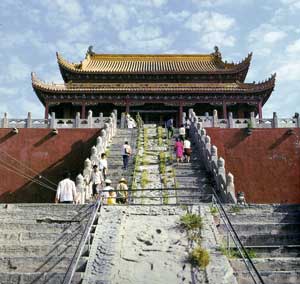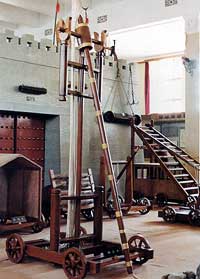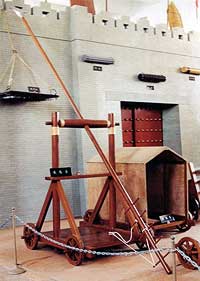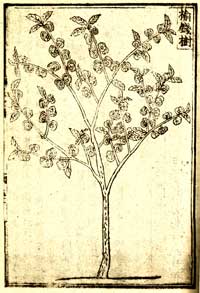|
|||||||||
|
FEATURESThe Elm Tree Palisades: The Great Wall of the Northern Song Fig. 1 Remains of Tang dynasty Great Walls in Chicheng county, Hebei province. Within China's annals of more than two and a half millennia of building Great Wall defensive systems, the Song dynasty (Northern, 960-1127 and Southern, 1127-1279) is regarded as one of the very few ruling polities, like the Tang, that did not engage in the construction of some form of defensive barricades along its northern borders. But the Tang did build walls (Fig. 1), and the Song, as shown in a recently published article, had their own approach to the need to barricade themselves from any potential enemy threatening their settled way of life. The Song dynasty is remembered today for its material culture and literature which preserve an image of genteel living and refined taste. In philosophy, the Song saw a resurgence of the examination system, intellectual enquiry and the emergence of a new sobriety, in which religious and secular ideas attained balance and synthesis. This was encapsulated in what later came to be called Neo-Confucian thought. Buddhism, Daoism and popular religion also flourished in this general atmosphere of dedication, idealism and tolerance. The visual arts of the Song dynasty captured the new balance and restraint. Painting and calligraphy attained unprecedented subtlety by dint of imperial patronage, exemplified by that of the artist and emperor Zhao Ji, better known by his temple name of Song Huizong (r. 1101-1125). The taste of the period is perhaps best expressed through the fine porcelain produced by kilns in the north and, later, the south. During the Northern Song, one of the most renowned of these was the Ding Kiln, located in Dingzhou, Hebei province, not far from the Northern Song capital. (Fig. 2 ) Despite the high quality of the wares, there was mass production of some items, and ceramics became an everyday commodity for the first time in Chinese history.  Fig. 2 Thin-bodied Ding kiln bowl with lotus petal pattern Height: 8.2cm Unearthed in 1969 from the crypt of the pagoda at Jingzhi-si [temple], Dingzhou, Hebei province. Now in the collection of the Dingzhou Municipal Museum. The Song dynasty emerged from the division of the Five Dynasties period (907-960) to weather successfully a simmering threat from the north for a century and a half from the time of its founding by Zhao Kuangyin (927-976). And, from the outset, the Song was no stranger to warfare. The founder of the Song dynasty never succeeded in bringing all of what had been China in the heyday of the Tang dynasty under his control. He brokered a precarious peace with the vast Liao state to the north established by the Khitan as early as 907. Prior to the founding of the Song, the Khitan rulers were receiving tribute from the Tibetans (Tubo), Tuyuhun, the pre-dynastic Tanguts, the Uyghur tribes and Arslan Turks, and they were close allies with the short-lived Latter Jin dynasty until they vanquished it in 946. In the first half of the 11th century, the Tanguts, an ethnic group that later converted to Tibetan Buddhism, established the Xixia or Western Xia dynasty centred on Ningxia and Inner Mongolia. With its northern hinterland crowded with the polities of different ethnic groupings gradually converging towards an agricultural—and dynastic—lifestyle, the Song oriented itself towards the south. Ironically, it was the Liao dynasty of the Khitan, not the Song, who resumed the Chinese perennial practice of building Great Walls of heavy masonry, as well as extensive trench systems, in the north.  Fig. 3 Longting (Dragon Pavilion) built on the site of the audience hall in the grounds of the Imperial City in the Northern Song capital, Bianliang (present-day Kaifeng). The territory of the Northern Song was limited to the Central Plains area, and did not extend much further north than the parallel of today's Tianjin. Zhao Kuangyin, the first Song emperor whose posthumous title was Song Taizu (r. 960-975), established his capital in Bianliang (Kaifeng), although today there are few remains of, but many monuments to, the Song period in that city. In what was once the Imperial City or the walled palace precincts of Song Bianliang, on the site of an imperial audience hall today there stands the Longting, or Dragon Pavilion. (Fig. 3) But it is a Qing structure built in 1692 by the Kangxi Emperor and it now houses a bargain basement waxwork 'likeness' of Zhao Kuangyin. The Military Face of the Song DynastyZhao Kuangyin was a skilled soldier, but the Song is not thought of today as a 'martial' dynasty. This impression is not only attributable to our appreciation of the refinement of its culture, but also to the fact that its government was effected through civilian administrators rather than regional military governors, as had been the case with the majority of preceding polities. However, in the Song dynasty, traditional combat weapons, referred to in Chinese military histories as 'cold weapons' (leng bingqi), reached the apogee of their development. The manufacture of firearms, or rather of weapons making use of gunpowder, also began in the Song. One of the priorities of the Song when establishing its capital in Bianliang was setting up large arsenals there under the direct control of the central government. Information concerning the weapons, military institutions and strategic philosophies of the Song dynasty is best obtained from a mid-11th century work titled Wujing zongyao (The essentials of military classics). The work was compiled by Zeng Gongliang (998-1078) and Ding Du (990-1053) in response to an imperial edict of Emperor Renzong (r. 1023-1063). The work comprises two sections, totalling 40 fascicles, and its illustrations have proved invaluable for later military historians. The original Song edition was lost, and the earliest we have dates from the years between the Hongzhi and Zhengde reigns, specifically between 1438 and 1521, and it was based on a Southern Song edition. In 1959, the prestigious academic publishing house Zhonghua Shuju photo-lithographed this edition, which was in the possession of scholar and bibliophile Zheng Zhenduo (see China Heritage Newsletter #4, Articles, 'Shaping the Forbidden City as an Art-Historical Museum in the 1950s'), and a reproduction of that work was also included in the collection titled Zhongguo gudai banhua congkan (The collection of ancient Chinese wood-block printed works), published by Shanghai Ancient Books Publishing House in four volumes in 1988.  Fig. 4 Photograph of a replica of a Song dynasty siege engine (paoshiji or paoche, ballista) from the Beijing Military Museum. (Source: Lu Xixing ed., Zhongguo gudai qiwu dacidian: bingqi, xingju [Comprehensive dictionary of ancient Chinese artefacts: Weapons and instruments of punishment], Shijiazhuang: Hebei Jiaoyu Chubanshe, 2004.)  Fig. 5 Photograph of replicas of two Song dynasty siege engines from the Beijing Military Museum. Left: eche or eguche, lit. 'swan-goose wagon' or 'pecking machine', designed to harass defenders on the top of walls. Right: fenyunche or fenwenche, a low armoured vehicle covered with fresh hide to prevent arrows penetrating, which could be pushed up against the base of fortified walls, while providing cover for moving materials or bringing in reinforcements of up to ten persons laying siege. (Source: as above.) The illustrations in this ancient military encyclopaedia reveal the high level attained by Song dynasty military inventors, designers and craftsmen, and the importance attached by the Song to weapons manufacture. The cold weaponry it includes and describes remained largely unchanged down to the Qing dynasty. Moreover, siege warfare and siege machinery are documented in great detail, indicating the great advances made by the Song in this area. The mastery of the many siege engines, such as the paoche, fenyunche and eguche, (Figs. 4 and 5) [Elm05.jpg & Elm06.jpg] described in this work would have made the Song armies a potentially formidable besieging force. The Song Dynasty under Siege and its WallsThe Song armies were not, however, prone to laying siege. The Song dynasty was itself under siege. The final collapse of the Song before invading Jurchen armies was preceded by a steady retreat, albeit diplomatic. The failure of barricades to hold back the enemy does not play a part in the Song demise as it is conventionally related in history books, to the extent that the Manchu advance into the Central Plains is described euphemistically as the entry through Shanhaiguan Pass of the Manchu armies. For this reason, the Song has never been regarded as a dynasty that built barriers like the Ming Great Walls to protect itself. Yet, in fact, as we will see below, there are many parallels in the way the defences these two dynasties put in place were sidestepped in the course of their fall. The Northern Song dynasty is not regarded as a dynasty that constructed defensive long walls, trench emplacements or barriers, unlike the rival Liao and Jin dynasties to their north. However, in an article published in the May 2006 issue of Inner Mongolia Social Sciences, Tao Yukun, an historian at Inner Mongolia Normal University, puts paid to that view. She shows, convincingly, that in the 11th century the rulers of the Northern Song drew on aspects of the long-standing defensive policies formulated by China's rulers of the Qin and Han dynasties, of erecting walls and barriers to prevent the southern incursion of peoples inhabiting the vast Eurasian steppe. But, as Tao describes, the 11th century Song dynasty's Ministry of Defence implemented a 'green belt' defensive policy that took the form of 'elm tree palisades' (yusai), a sustainable, living 'Great Wall' that would have partly offset environmental degradation in northern China. The Great Walls of ElmThe stand-off between the Song dynasty and the northern nomadic pastoral peoples began in the mid-11th century. The encroachment of the proclaimed Liao dynasty of the Khitan people into northern China was signalled by its occupation of the Sixteen Prefectures of Yan-Yun, including present day Beijing and northern Hebei. The area the Khitan then controlled extended south of the line of earlier Great Walls first delineated by the Yan state and Qin and Han dynasties in the third and second centuries BCE. As a result of Khitan advances, the border between the Liao and Song ran in a line from the Baigouhe River in the east, and extended, at the centre, through today's northern Hebei and central Shanxi provinces. The area of the North China Plain, to the east of the Taihang Mountains, was vulnerable Song territory, and the plains lacked topographical features that lent themselves to the easy construction of forts, such as those that commanded mountain passes to the north. To defend itself in the face of escalating territorial threat, the Song government constructed a series of connected ponds and lakes (called tangbo) running from Baozhou (present day Baoding) in the west to Cangzhou in the east. The administrative centre or zhisuo of Song dynasty Cangzhou was in present day Cangxian county, Hebei province. The network of lakes was designed to thwart the Liao cavalry, against whom the Song also had recourse to primitive non-explosive landmines and spiked obstacles named for their shape 'puncture vines' (jili or Tribulus terrestris). The lines of natural and man-made lakes were unfortunately seasonal and they either froze over in winter, enabling the Khitan horsemen to cross, or they dried up in the late autumn or early spring. The lakes were therefore supplemented by a dense network of trees, which were called 'the elm palisades' (yusai). The extent to which the Chinese or lacework elm (Ulmus parvifolia), as opposed to other varieties of trees, was planted to form the palisades cannot be ascertained from the brief historical records of this defensive experiment in reforestation. However, there is a reference in Song huiyao jigao (The compiled manuscripts containing important documents of the Song), cited by Tao Yukun, to an order issued by Emperor Shenzong in 1072 to plant 'mulberries, dates, elms and willows' on the northern frontier between Cangzhou and the Liao.  Fig. 6 Illustration of lacework elm tree (yushu or yuqianshu) from a Ming edition of the pharmacopoeia titled Jiuhuang bencao (Pharmacopoeia for relieving years of plight), dated 1525. The lacework elm has many uses, and its leaves, bark and other parts are included in many Chinese pharmacopoeias. (Fig. 6) [Elm02.jpg] Moreover, it is a hardy native of the harsh climate of north China and it does well in poor soil, whether sand, clay and loam. In recent years lacework elm trees have been planted in areas of Inner Mongolia in an attempt to halt desertification, and it is being introduced, on an experimental basis, as a street-side shade tree in parts of the USA because it is free from Dutch elm disease. It grows up to 18m in height and, when closely planted, its broad pendulous branches form thickets that would be difficult for cavalry to penetrate. Elm trees were planted along the borders of the Song dynasty's Hebei 'Lu' or 'circuit', the political division equivalent to a contemporary province. The elm palisades were planted between the lakes and ponds; they were also planted on all high ground, along official roads and around settlements. To the west in the Taihang Mountains, the terrain that formed the borders between the Song dynasty's Hedong Lu and the Liao domains was high wooded ground, and here the Song issued orders that forests be conserved, effectively forming a second tier of 'elm palisades'. However, because of the paucity of relevant historical documentation, we have little detailed information today about the full extent of the elm palisades of the Song. Later Policy ReversalIn adopting this policy of planting and using existing forests for defence, the Song military policy-makers were emulating what little was known of an aspect of Qin-Han defence strategies mentioned only in passing reference to Meng Tian in Han shu and other early texts, but cited as a precedent by Song defence policy officials. The policy of protecting forests to defend the state's borders and the ban on tree-felling created unemployment in some places and resulted in a shortage of firewood. Concerned by this situation, Han Qi, a military official from the Dingzhou Lu alerted the throne to the problem in a memorial of 1049: 'The court has banned the felling of trees in areas adjacent to the borders in order to obstruct the entry of barbarians and marauders into this circuit. A blanket ban was also implemented at that time on land clearance for farming in the low hilly areas near villages, and this resulted in many of the inhabitants of the borderlands suddenly losing any means of employ. Now the price of firewood and fuel has soared, and the policy has had the inverse effect of enabling the enemy to reap enormous profits from our shortfall. I have sent out inspectors to determine in which areas these bans should be applied and believe that a shelter belt between us and the enemy of fifty or sixty li is sufficiently wide to ensure our defence. So I have redrawn the boundaries where the bans apply and have issued a proclamation allowing timber felling in the areas where bans are felt to be no longer necessary'. This would seem to be a reversal of an earlier ordinance issued by Han Qi himself not permitting any tree-felling north of Dingzhou. Environmental ProtectionThis defensive policy of enhancing and protecting forests also served to protect the environment of northern China. In his study of changes in the vegetation cover of north China, Zhu Shiguang pointed out that in the historical period most depletion of the tree cover in the region resulted from human agency. However, in his discussion of the entire period of more than two and a half millennia from the Western Zhou to the Qing dynasty, he omitted the Song, Liao and Jin dynasties from his discussion. Tao Yukun believes that the Song policy may have reversed this general historical trend, even if only for a short time. By the time of the Xining reign period (1068-1077), the Liao was demanding that the Song redraw the boundaries of Hedong Lu. The Song resolved to strengthen their borders and augment the 'elm palisades', establishing an office in 1073 under Huo Shunfeng to oversee them, but in 1078 Huo was dismissed and the initiative came to nought. The palisades aroused the ire of the Liao, who covertly and overtly despatched axmen to fell the trees. However, a way through the elm thickets facilitating the passage of cavalry travelling in more than single file was finally cut by the Northern Song official Tong Guan (1054-1126). In an attempt to form an alliance with the Jurchen (Jin dynasty) against the Khitan's Liao dynasty, he launched an attack along the corridors he felled through the elm palisades and attempted to recover the Yan-Yun prefectures. He was unsuccessful in battling the Liao, and sought help from the Jin, who occupied Yanjing (Beijing) in his stead. The Jin honoured Tong Guan for his contribution to their victory and appointed him prince of Guangyang. In 1125, Tong was in Taiyuan, when he heard the news that the Jin troops had made the most of the opportunity he extended to them and had conquered the Northern Song capital Bianliang. Tong Guan rushed south to join the Song emperor Huizong who was preparing to flee to southern China, but, for his part in the collapse of the Northern Song and Huizong's subsequent death, Tong was sentenced to death by Emperor Huizong's successor Qinzong, who reigned for the final year of the Northern Song. For Tong Guan, and the Song, the proverbial Birnam Wood to Dunsinane had come. [BGD] ReferencesTao Yukun, 'Bei Song fangyu Liaoguo de yusai' (The elm palisades that form the Northern Song defences against the Liao state), Nei Menggu shehui kexue (Inner Mongolia Social Sciences), 2006:3, pp 36-39. Zhu Shiguang, 'Lishi shiqi Huabei pingyuan de zhibei bianqian' (Changes in the tree cover of the North China Plain during the historical period), Shaanxi Shifan Daxue xuebao: Ziran kexue ban, 1994:4, cited by Tao Yukun in the above. |